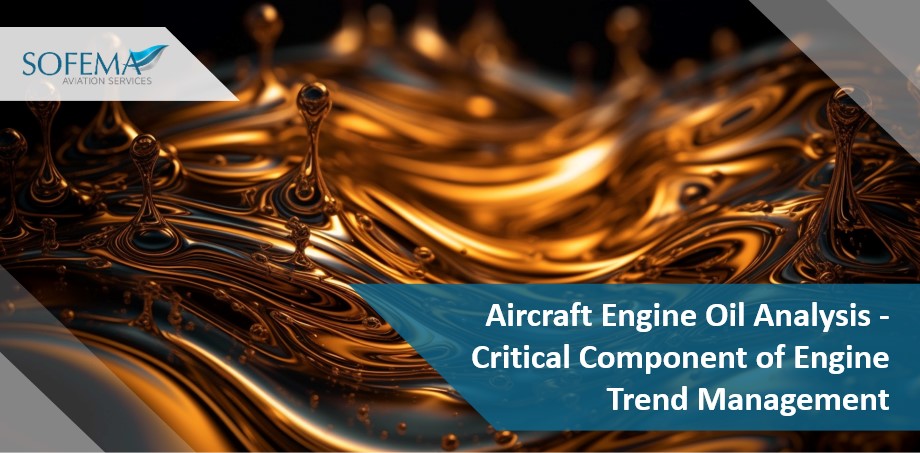Sofema Aviation Services (SAS) www.sassofia.com considers the key elements of a Robust Engine Oil Assessment & Analysis Process to support Engine Condition Trend Monitoring ECTM process.
Introduction – Aircraft Engine Magnetic Chip Detectors
Magnetic chip detectors play a crucial role in maintaining aircraft engine health. By providing early detection of metallic debris, they help prevent catastrophic failures, optimize maintenance schedules, enhance safety, and reduce operational costs. Implementing best practices in their use ensures engines remain in optimal condition, contributing to the overall reliability and safety of aircraft operations.
- Early detection of wear enables early intervention which can prevent minor issues from becoming major failures.
Detectors generate a strong magnetic field to attract ferrous particles & as oil circulates through the engine, any metal particles accumulate on the magnetic surface of the detector.
Types of Wear Detected – Normal Wear / Abnormal Wear
- Normal – Small amounts of metal particles from typical engine operation.
- Abnormal – Larger or unusual metal particles indicating abnormal wear patterns.
Trend Analysis
- Analyze the quantity and type of particles over time.
- Identifies increasing wear trends and predicts potential failures.
- Respond promptly to alerts from advanced chip detectors.
Detection of Metallic Debris
- To capture and hold ferrous (iron-based) metal particles suspended in the engine oil.
>> Magnetic elements attract and hold metal debris, preventing it from circulating through the engine and causing further damage.
>> Identifies wear particles from components such as bearings, gears, and other critical engine parts.
Monitoring Engine Health
- Provide real-time monitoring of engine condition.
- Regularly checked during maintenance to assess the quantity and type of metal particles, indicating wear rates and potential issues.
Oil Analysis
- Oil analysis can indicate engine issues.
Functions of Engine Oil
- Friction Control – Separates moving surfaces to reduce friction.
- Wear Control – Minimizes abrasive wear on engine components.
- Corrosion Control – Protects engine parts from corrosive substances.
- Temperature Control – Absorbs and transfers heat away from engine parts.
- Contamination Control – Transports particles and contaminants to filters or separators.
Oil Testing Methods
- Elemental Analysis (Spectral Analysis) – Detects the presence of wear metals and contaminants.
- Particle Count – Measures the number of particles in the oil.
- Particle Shape Analysis – Examines the shape of particles to determine wear mechanisms.
- Parts per Million (PPM) Distribution – Quantifies the concentration of various elements.
Ferrography – Analyzes ferrous particles to assess wear severity.
- Oil Chemistry Analysis
- Water-in-Oil Analysis
- Viscosity Measurement
- Wear Debris Analysis (WDA)
- Wear Metals and Metallic Additives
Wear Metals
- Titanium: Indicates wear from bearings or contamination from paint.
- Vanadium: Found in fuel or as an alloying element in steel.
Metallic Additives
- Sodium: Corrosion inhibitor, coolant leak indicator, or road salt contaminant.
- Boron: Corrosion inhibitor, anti-wear/antioxidant additive, coolant leak indicator.
- Magnesium: Detergent/dispersive additive, steel alloy component.
- Calcium: Detergent/dispersant additive, indicates grease contamination.
- Molybdenum: Anti-wear additive, found in bearings.
- Barium: Corrosion inhibitors, detergents, rust inhibitors.
- Zinc: Anti-wear, corrosion inhibitors, antioxidants, bearing alloy.
- Phosphorus: Anti-wear, corrosion inhibitors, antioxidants, extreme pressure additives.
Next steps
Follow this link to our Library to find & download related documents for Free.
Sofema Aviation Services and Sofema Online provide EASA and other Regulatory Compliant and Vocational Short Courses – as Classroom, Webinar and Online Training Courses – Please see the websites or email team@sassofia.com.
Tags:
Assessment, Engine Condition Trend Monitoring, SAS blogs, Corrosion control, Engine Condition Trend Monitoring (ECTM), Temperature Control, Engine Oil, Robust Engine Oil, Analysis Process, Trend Analysis, Metallic Debris, Monitoring Engine Health, Oil Analysis, Friction Control, Wear Control, Contamination Control





